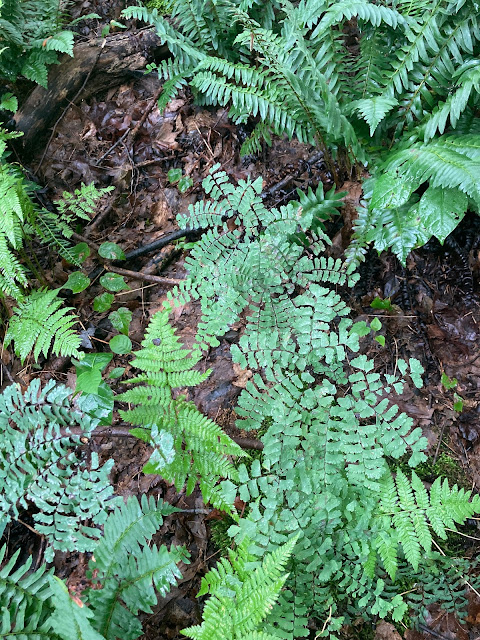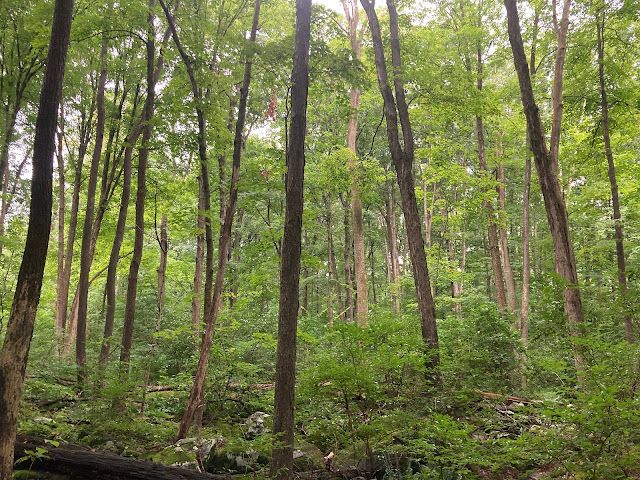 |
| Adiantum pedatum |
Perhaps a maidenhair fern will strike your fancy? I am always amazed on social media when I post a fern or conifer there are significantly fewer views and "likes" (and do we not live for "likes"?). Green is apparently an inferior color in Cyberspace. But in the parched West, a sweep of maidenhair fern is a tonic! I spent two wonderful days [bracketing the Perennial Plant Association conference] exploring the woods around Lancaster and Mohnton where my friends Mike and Jan Slater live. Don't get me wrong: I LOVED the conference--but time with friends and woodland wonders--well that's the ticket!
 |
| Melange of Polystichum acrostichoides and Dryopteris sp. |
In this same patch of woods-
 |
| Dryopteris marginalis |
I've grown this wonderful shield fern most of my life. Can't imagine living without it--and seeing it in the wild was a treat.
More ferny melanges: finding three large ferns like this close together in Colorado would be a feat!
 |
| Polystichum acrostichoides |
I gained a new love for the Christmas fern in this patch of woods--they were everywhere and magnificent!I
A towering hickory (I believe): Mike told me these woods had probably been logged three or four times--but they felt like virgin forest to me.
 |
| Polystichum acrostichoides |
Here is our friend growing in a rock crevice: not a fern I'd hitherto planned for my crevice garden!
More maidenhair: you can never have enough of this.
 |
| Polypodium virginianum |
And the obligatory polypody on a rock...
 |
| Lots of them actually! |
 |
| Symplocarpus foetidus |
Not the most imposing specimen of skunk cabbage--but still fun to find. Last time I saw one was in a Chicago wildland blooming on my birthday (late March).
 |
| Hepatica americana |
As with maidenhairs--one cannot have too many hepaticas.
Mike was thrilled to see that the sole Cypripedium pubescens (I know they've changed the name, btw) has set seed. He'd personally pollinated this flower with pollen from a friend's ladyslipper from nearby.
 |
| Asarum canadense |
I'm not alone in loving the wild gingers...I suspect anyway!
A trunk of an ash tree felled by the Ash borer. We saw tremendous germination of ashes in the woods here and elsewhere: will the borer return after they've killed all the big ones?
 |
| Mike Slater |
Mike is an outstanding naturalist: not only does he know the vascular plants, but mosses, liverworts--you name it!--and let's not even talk about birds, invertebrates and more! You couldn't have had a better guide hereabouts--and his and Jan's garden is stunning as well!
This was one of Mike's favorite spots: I heartily concurred!
I have been in love with the eastern woodlands even before I first walked in them: the sublime diversity of trees, the lush undergrowth, and the ferns, ephemerals and other gems lurking beneath them. This patch of woods is one I shall long remember!






















It is too bad there are so many invasive species taking over the native plants. The ones I see are Japanese stilt grass, Asian bush honeysuckle, multiflora rose. Possibly even Norway maple taking the place of sugar maple in the canopy.
ReplyDeleteMike was voluble about the invasive threats too, James. I was impressed by how few we found in a number of forays into lots of different woods: but then he probably picked those spots because they were pristine.
ReplyDeleteWhen a tree falls, the gap in the canopy becomes filled with invasive species. Ecologist call what they see happening extinction lag or debt. Although the losses may not always be happening rapidly, without intervention they are continually occurring. This can be seen if a historical survey of a plot or transect is compared with what is currently present.
DeleteThe ferns do better than other native species when facing pressure from invasive species. Ferns can live on soil too thin or in areas too dark for many invasive species to colonize. The question of if an area is pristine is not what is currently present, but if species previously present have been lost. Unfortunately, so little surveying has been done we often don't even know what we are losing.
It is a nice little spot with ferns and boulders. The maples here at this little sot are Sugar Maple and Red Maple and with Norway Maple. There are a lot of invasive plants around though and the Asian shrubby honeysuckles are some of the worst, here it's Lonicera mackii (Amur Honeysuckle).
ReplyDeleteHas there been any effort to control invasive species? If so, has it been successful?
DeleteSome, but the whole area is a public hunting land with several thousand acres and a small staff. The staff is in tested in helping out that particular spot though. They have done some removal of Lonicera.
ReplyDeleteI thought some work might have been done because of the dead Lonicera in the picture showing the skunk cabbage. In Illinois, various preserves have volunteer led “Friends of …” groups that do invasive species control work and help with other maintenance in preserves. This is largely the result of Stephen Packard’s work to develop what they call “Community Stewardship.”
ReplyDelete